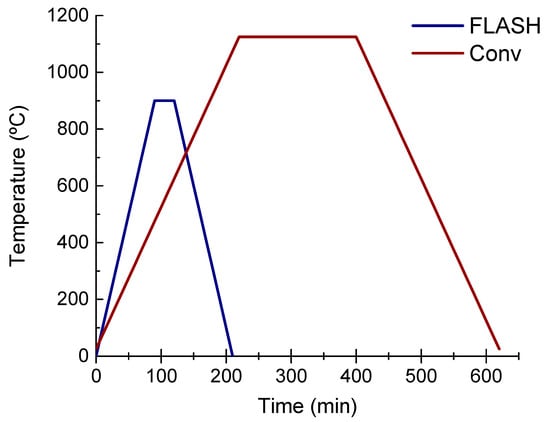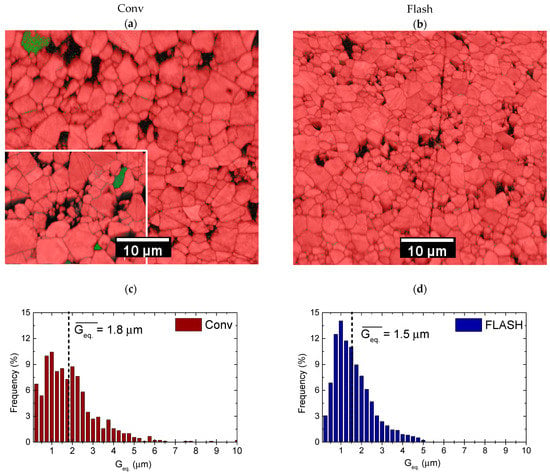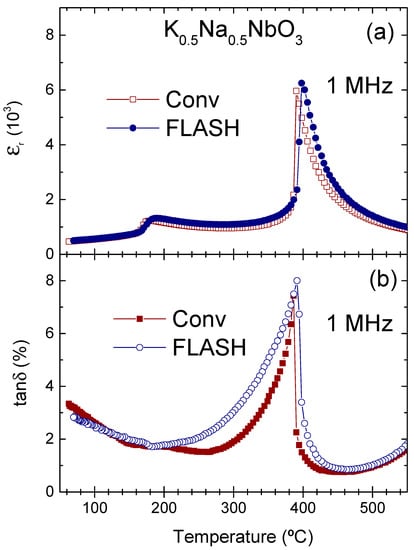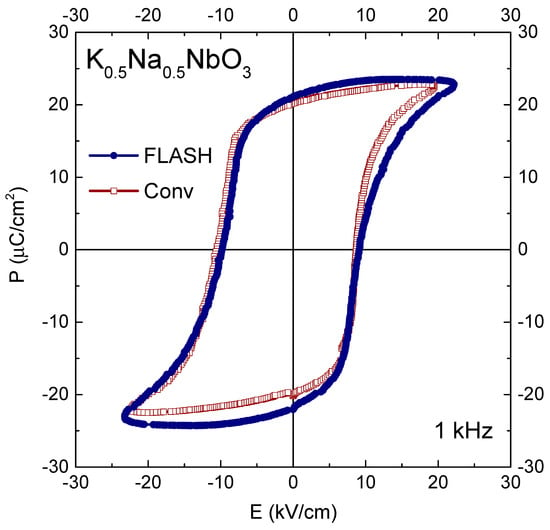Abstract
Alternative sintering technologies promise to overcome issues associated with conventional ceramic sintering such as high thermal budgets and CO2 footprint. The sintering process becomes even more relevant for alkali-based piezoelectric ceramics such as K0.5Na0.5NbO3 (KNN) typically fired above 1100 °C for several hours that induces secondary phase formation and, thereby, degrades their electrical characteristics. Here, an ability of KNN ceramics to be of high performance is successfully demonstrated, using an electric field- and current-assisted Flash sintering technique at 900 °C only. Reported for the first time, Flash sintered KNN ceramics have room-temperature remnant polarization Pr = 21 μC/cm2 and longitudinal piezoelectric coefficient d33 = 117 pC/N, slightly superior to that of conventional ones due to the reduced content of secondary phases. High-performance KNN ceramics Flash sintered at a low-thermal budget have implications for the development of innovative low carbon technologies, electroceramics stakeholders, and piezoelectric energy harvesters.
1. Introduction
Motivated by the need to replace lead-based piezoelectrics, alkali niobates have been reported as one of the most promising family of lead-free piezoelectric compounds for applications in sensors, actuators, and energy-harvesting devices []. The interest in potassium sodium niobate (K0.5Na0.5NbO3, KNN) resides also in its high tetragonal to cubic transition temperature (TC) and longitudinal piezoelectric coefficient, d33 [,]. Non-textured and non-doped ceramics present, typically, d33 of 80–200 pC/N with the tetragonal symmetry phase being stable up to TC of 420 °C [].
Conventional production of KNN ceramics meets however some experimental limitations [,,,]. The high temperature and long sintering time induce the volatilization of alkali elements, and thereby the formation of secondary phases with negative effect on both TC and d33 []. Among possible solutions such as an initial alkali excess, which has to be adjusted to each particular set of preparation conditions, and sintering aids, which have to be also carefully selected, the use of alternative, low-temperature, sintering methods to densify KNN ceramics [] looks most attractive. Recently, we have used Spark Plasma Sintering and Texturing (SPS/SPT) to produce high-density ceramics at a temperature of 1000 °C for 20 min, with relatively high d33 (95–108 pC/N) and moderate TC (370–386 °C) []. However, in SPS/SPT, the use of graphite dies and reducing atmospheres implies a post heat treatment for several hours [], not to mention the limitation in terms of produced shapes [].
Flash sintering, an electric field- and current-assisted technique [], has been presented as a possible solution for the sintering of KNN [,,,], with reduced thermal budget. Ceramic densification has been shown to occur at a lower temperature and in a much shorter period of time, when an electric field is directly applied to a green body [,,]. However, while a large part of the articles on Flash sintering is focused on the sintering process itself and parameters affecting its equilibration, the piezoelectric and ferroelectric properties of Flash sintered KNN have not been disclosed so far. In this work, these key properties required for piezoelectric applications are reported, for the first time, for Flash sintered KNN ceramics and compared with those of conventionally sintered ceramics.
2. Materials and Methods
K0.5Na0.5NbO3, KNN, single phase powders were produced by solid-state reaction, using high purity alkali carbonates (K2CO3, Sigma-Aldrich, St. Louis, MI, USA, 99.99% and Na2CO3, Sigma-Aldrich, 99.999%) and niobium oxide (Nb2O5, Alfa Aesar, Haverhill, MA, USA, 99.9%). Powder characterization and processing details are published elsewhere [,] as well as Flash sintering setup scheme and mechanism []. In short, green compacts (ca. 15 × 5 × 2 mm3) were uniaxially and isostatically pressed to a green density of ca. 65%. These pellets were sintered in an adapted contact-dilatometer, with or without the application of an electric field, respectively, for Flash and conventional processes. The conventional sintering (Conv) cycle was optimized to obtain high-density ceramics, using 5 °C/min heating and cooling rates and a sintering temperature of 1125 °C with a 3 h dwell, as shown in Figure 1. Considerably lower thermal budget conditions were used for Flash sintering, as also seen from Figure 1. The pellets were placed in-between two platinum foil electrodes and heated to 900 °C at a rate of 10 °C/min. After an isothermal step of 30 min, a 300 V/cm electric field was applied, and the current limit set to 20 mA/mm2, while the holding time after the Flash event was 60 s []. A decrease of 20% in the maximum furnace temperature and 66% in the cycle time was accomplished when using Flash instead of the conventional sintering.

Figure 1.
Thermal profiles used for sintering of KNN ceramics by conventional (Conv) (Tmax = 1125 °C, timeTotal = 620 min) and Flash (Tmax = 900 °C, timeTotal = 210 min) processes. A considerably lower thermal budget is involved for Flash when compared with conventional sintering.
The microstructure and local structure of the sintered ceramics were analysed using field-emission scanning electron microscope (SEM, Hitachi SU-70, Tokyo, Japan) equipped with an Electron Backscattered Diffraction (EBSD) detector (EBSD Bruker e-Flash Quantax CrystAlign, Billerica, MA, USA) at 25 kV acceleration potential. EBSD phase analysis is done using ESPRIT software. Prior to the analysis, ceramics were polished using SiC papers, diamond paste and colloidal silica. The density of the ceramics was determined by the Archimedes method with correction for the open porosity on at least three specimens, using water as the immersion liquid.
To access the dielectric, ferroelectric and piezoelectric behaviour of KNN ceramics, 1 mm thick specimens with ca. 5 × 3 mm2 section areas were prepared from sintered bodies, using a diamond cutting wire and SiC papers for thickness reduction. After a fine polishing (SiC P2500), platinum electrodes were brush painted (SPI-CHEM 04990-AB, West Chester, PA, USA) at the opposite faces of the ceramics, for a parallel-plate-capacitor configuration. A drying step at 50 °C was employed, followed by a cure and sintering electrode process, according to the manufacturer indications (maximum temperature of 900 °C, for 1 h).
The real part of the relative dielectric permittivity (εr) and dissipation factor (tanδ) were accessed using a precision LCR-meter (HP 4284A, Santa Clara, CA, USA), with a 1 V oscillation potential and the frequency of 1 MHz. The temperature dependence was obtained on cooling the ceramics after heating in a tubular furnace with an alumina sample holder, using a 2 °C/min rate, and a dwell time of 2 min before each measurement. The polarization, as a function of the AC electric field of the sintered ceramics, was assessed at 1 kHz and at room temperature with a ferroelectric analyser (aixACCT, TF Analyzer 2000, Aachen, Germany). The longitudinal piezoelectric coefficient (d33) of these KNN ceramics was measured after a non-destructive Corona poling step at 70 °C, for 15 min, under the potential of 10 kV, followed by an additional 15 min step, at 65 °C, under 12.5 kV. A Berlincourt-type piezoelectric meter (Sinocera YE 2730A, Shanghai, China) with force frequency of 110 Hz and amplitude of 0.25 N was used. Several measurements were performed as on the same specimen as on different ceramics to determine an average d33 value and the respective standard deviation.
3. Results and Discussion
KNN Flash and Conv ceramics have a relative density of 93 3% and 96 2%, respectively. Dense microstructure with an estimated porosity between 3% and 5% for both Conv and Flash KNN ceramics is also seen in SEM-EBSD micrographs, shown in Figure 2a,b, respectively, although some grains were evidently pulled out during polishing that is particularly well seen for Conv KNN with larger grains. The grain size distributions from 0.25 to 10.0 μm and from 0.25 to 5.0 μm are seen in Figure 2c,d for Conv and Flash KNN ceramics, respectively. The average equivalent grain size () is almost 1.8 μm for Conv KNN and ~1.5 μm for Flash ceramics. Thus, not only the smaller average grain size is obtained by the Flash process, but also the ceramic grain size distribution is narrower, when compared with conventional sintering, as evidenced in Figure 2.

Figure 2.
EBSD-phase mapping (a,b) and equivalent grain size (Geq.) distribution (c,d) deduced from them for conventional (a,c) and Flash (b,d) sintered KNN ceramics. Red colour in the maps indicates the indexation with JCPDF file 01-085-7128, K0.5Na0.5NbO3 orthorhombic symmetry phase, and green colour with file 04-007-9405, K0.8Nb5O15 tetragonal secondary phase. Inset of (a) reveals another EBSD mapping for Conv KNN with the secondary phase being systematically indexed in several grains.
Regarding the local structure, the EBSD phase-maps in Figure 2a,b, reveal grains separated by a dark colour, indicating a discontinuity in the crystal structure, orientation, or composition. The red colour is associated with K0.5Na0.5NbO3 orthorhombic symmetry phase (JCPDF file 01-085-7128), while the green colour corresponds to Nb-rich tetragonal symmetry of K0.8Nb5O15 secondary phase (JCPDF file 04-007-9405). Conv KNN ceramics evidently contains grains of the Nb-rich phase as clearly seen in Figure 2a. The inset of Figure 2a shows that this secondary phase is systematically observable throughout the conventionally sintered ceramics. In contrast, secondary phases are hardly detectable in Flash ceramics, with just a few small indexations at the grain boundaries (see Figure 2b). Several EBSD analyses consistently revealed the concentration of the secondary phase in Conv KNN to be 0.25 to 0.50 vol.%, whereas that for Flash ceramics was found to be <0.05 mol.%.
The variation of the relative dielectric permittivity and dissipation factor of Conv and Flash KNN ceramics measured on cooling at a frequency of 1 MHz is demonstrated as a function of the temperature in Figure 3a,b, respectively. A pair of peaks in the temperature dependence of the permittivity is observed and associated with structural phase transitions, as expected for KNN []. For Conv KNN, the orthorhombic to tetragonal phase transition corresponds to a peak at TO−T = 181 °C, with the peak εr = 1225, and the tetragonal to cubic phase transition corresponds to another peak at TC = 390 °C, with εr = 5963. In the case of Flash ceramics, both the peak permittivity values and temperatures are slightly superior when compared with Conv KNN. εr is of 1321 at TO−T = 190 °C and of 6249 at TC = 398 °C. The increase of the relative permittivity and transition temperatures for Flash ceramics compared to Conv KNN can be related to the deviation from the stoichiometry associated with the secondary phases, prevalent in Conv KNN [] and suppressed in Flash ceramics. This behaviour is accompanied by a respective peak in dissipation factor (tanδ) that occurs at TC for both ceramics. The value of tanδ reaches a maximum of about 8% at TC, decreasing towards ≈2% at TO−T, and then slightly increasing during the further cooling.

Figure 3.
Real part of the relative dielectric permittivity, εr (a), and dissipation factor, tanδ (b), of conventionally (squares) and Flash (circles) sintered KNN ceramics measured as a function of temperature, at 1 MHz, on cooling.
A slight superiority of Flash ceramics over Conv KNN is visible as well in the room-temperature polarization (P) behaviour as a function of the applied AC (1 kHz) electric field (E), illustrated in Figure 4. At a rather similar coercive field of 10 kV/cm, remnant polarization values of 20 and 21 μC/cm2 are obtained for Conv and Flash ceramics, respectively. In terms of the piezoelectric performance at room temperature, d33 piezoelectric coefficient of 115 for Conv KNN is also slightly lower than 117 pC/N for Flash ceramics.

Figure 4.
Polarization (P) as a function of applied electric field (E) of conventionally (open squares) and Flash (solid circles) sintered KNN ceramics, measured at 1 kHz and room temperature.
Table 1 summarizes the most relevant properties of Flash and conventional KNN ceramics studied in this work, presenting also a comparison with other KNN ceramics, produced either by alternative microwave (MW) assisted [] and SPS/SPT sintering techniques [] or by conventional processes [,], as well as with KNN single crystal []. The TC value of 398 °C for Flash KNN is very similar to that reported by Birol and co-workers [] for conventionally sintered KNN. Furthermore, it is higher than that reported for SPS/SPT ceramics []. The decrease in comparison with the TC of 429 °C for KNN single crystal [] is explained by the presence of impurities, grain boundary-localized secondary phases and crystal structure defects or residual stresses, usually present in ceramics and less common or absent in single crystals. Values of the permittivity and dissipation factor at TC of the produced ceramics are also in agreement with the literature.

Table 1.
Relative density (ρrel.), average equivalent grain size (), orthorhombic to tetragonal (TO−T), and tetragonal to cubic (TC) transition temperatures, relative dielectric permittivity (εr) and dissipation factor (tanδ) at TC and room temperature (RT), as well as RT remnant polarization (Pr), coercive field (Ec) and piezoelectric coefficient (d33) of Flash and Conv KNN ceramics of this work in comparison with literature reports.
A ferroelectric analysis reveals that the remnant polarization for Conv and Flash KNN ceramics is close to those reported for KNN ceramics and single crystals [,,,]. On the other hand, the coercive field is closer to that of SPT ceramics [] and KNN single crystals [], being lower than that for SPS [] and conventionally sintered KNN reported by Birol et al. []. In addition, the piezoelectric coefficient of 117 pC/N determined for Flash ceramics is superior not only compared with Conv KNN of the current work but also with all KNN reported in the literature [,,] except for the [001]-oriented single crystals []. Thus, KNN ceramics obtained by Flash sintering in spite of the reduced thermal budget can provide an electrical behaviour similar or in some cases even better than that of ceramics sintered conventionally or by other methods.
4. Conclusions
In conclusion, the dielectric, ferroelectric and piezoelectric behaviour of KNN ceramics produced by Flash sintering (Tmax = 900 °C, timeTotal = 210 min) was presented for the first time and found to be slightly superior to that obtained using conventional sintering technique (Tmax = 1125 °C, timeTotal = 620 min) or by other methods reported in literature. The superior behaviour was explained by the lower content of secondary phase detected using EBSD analysis. Flash sintered KNN ceramics are characterized by εr = 6249 and tanδ = 0.08 at TC of 398 °C as well as Pr = 21 μC/cm2, Ec = 10 kV/cm and d33 = 117 pC/N at room temperature. As a result, Flash can be considered as a fast electric field- and current-assisted sintering process with low thermal budget suitable for producing high-performance lead-free piezoelectric ceramics for sensor, actuator, and energy-harvesting applications.
Author Contributions
Conceptualization, P.M.V. and A.M.O.R.S.; methodology, R.S.; validation, R.S.; formal analysis, R.S., A.T., L.P., A.M.O.R.S. and P.M.V.; investigation, R.S.; resources, P.M.V. and A.M.O.R.S.; data curation, R.S.; writing—original draft preparation, R.S.; writing—review and editing, A.T., L.P., A.M.O.R.S. and P.M.V.; visualization, R.S. and A.T.; funding acquisition, P.M.V. and A.M.O.R.S. All authors have read and agreed to the published version of the manuscript.
Funding
This work was developed within the scope of the project CICECO-Aveiro Institute of Materials, UIDB/50011/2020, UIDP/50011/2020 and LA/P/0006/2020, financed by national funds through the FCT/MEC (PIDDAC). This work was also financed by Portugal 2020 through European Regional Development Fund (ERDF), in the frame of Operational Competitiveness and Internationalization Programme (POCI), in the scope of the project “FLASH sintering of lead free functional oxides towards sustainable processing of materials for energy and related applications—FLASH”, POCI-01-0247-FEDER-029078. FCT is acknowledged for financial support by Ricardo Serrazina (SFRH/PD/BD/128411/2017) and Alexander Tkach (2021.02284.CEECIND).
Institutional Review Board Statement
Not applicable.
Informed Consent Statement
Not applicable.
Data Availability Statement
The data presented in this study are available on request from the corresponding author.
Conflicts of Interest
The authors declare no conflict of interest.
References
- Li, J.F.; Wang, K.; Zhu, F.Y.; Cheng, L.Q.; Yao, F.Z. (K,Na)NbO3-based lead-free piezoceramics: Fundamental aspects, processing technologies, and remaining challenges. J. Am. Ceram. Soc. 2013, 96, 3677–3696. [Google Scholar] [CrossRef]
- Ahtee, M.; Newat, A.W. Structural phase transitions in sodium-potassium niobate solid solutions by neutron powder diffraction. Acta Cryst. A 1978, 34, 309–317. [Google Scholar] [CrossRef]
- Saito, Y.; Takao, H.; Tani, T.; Nonoyama, T.; Takatori, K.; Homma, T.; Nagaya, T.; Nakamura, M. Lead-free piezoceramics. Nature 2004, 432, 84–87. [Google Scholar] [CrossRef] [PubMed]
- Shrout, T.R.; Zhang, S.J. Lead-free piezoelectric ceramics: Alternatives for PZT? J. Electroceram. 2007, 19, 111–124. [Google Scholar] [CrossRef]
- Zuo, R.; Rödel, J.; Chen, R.; Li, L. Sintering and electrical properties of lead-free Na0.5K0.5NbO3 piezoelectric ceramics. J. Am. Ceram. Soc. 2006, 89, 2010–2015. [Google Scholar] [CrossRef]
- Malič, B.; Koruza, J.; Hreščak, J.; Bernard, J.; Wang, K.; Fisher, J.G.; Benčan, A. Sintering of lead-free piezoelectric sodium potassium niobate ceramics. Materials 2015, 8, 8116–8146. [Google Scholar] [CrossRef] [PubMed]
- Matsubara, M.; Yamaguchi, T.; Kikuta, K.; Hirano, S.I. Sinterability and piezoelectric properties of (K,Na)NbO3 ceramics with novel sintering aid. Jpn. J. Appl. Phys. 2004, 43, 7159–7163. [Google Scholar] [CrossRef]
- Shirane, G.; Newnham, R.; Pepinsky, R. Dielectric properties and phase transitions of NaNbO3 and (Na,K)NbO3. Phys. Rev. 1954, 96, 581–588. [Google Scholar] [CrossRef]
- Pavlič, J.; Malič, B.; Rojac, T. Microstructural, structural, dielectric and piezoelectric properties of potassium sodium niobate thick films. J. Eur. Ceram. Soc. 2014, 34, 285–295. [Google Scholar] [CrossRef]
- Pinho, R.; Tkach, A.; Zlotnik, S.; Costa, M.E.; Noudem, J.; Reaney, I.M.; Vilarinho, P.M. Spark plasma texturing: A strategy to enhance the electro-mechanical properties of lead-free potassium sodium niobate ceramics. Appl. Mater. Today 2020, 19, 100566. [Google Scholar] [CrossRef]
- Biesuz, M.; Grasso, S.; Sglavo, V.M. What’s new in ceramics sintering? A short report on the latest trends and future prospects. Curr. Opin. Solid State Mater. Sci. 2020, 24, 100868. [Google Scholar] [CrossRef]
- Biesuz, M.; Sglavo, V.M. Flash sintering of ceramics. J. Eur. Ceram. Soc. 2019, 39, 115–143. [Google Scholar] [CrossRef]
- Corapcioglu, G.; Gulgun, M.A.; Kisslinger, K.; Sturm, S.; Jha, S.K.; Raj, R. Microstructure and microchemistry of flash sintered K0.5Na0.5NbO3. J. Ceram. Soc. Jpn. 2016, 124, 321–328. [Google Scholar] [CrossRef]
- Serrazina, R.; Senos, A.M.O.R.; Pereira, L.; Dean, J.S.; Reaney, I.M.; Vilarinho, P.M. The Role of Particle Contact in Densification of FLASH Sintered Potassium Sodium Niobate. Eur. J. Inorg. Chem. 2020, 2020, 3720–3728. [Google Scholar] [CrossRef]
- Serrazina, R.; Dean, J.S.; Reaney, I.M.; Pereira, L.; Vilarinho, P.M.; Senos, A.M.O.R. Mechanism of densification in low-temperature FLASH sintered lead free Potassium Sodium Niobate (KNN) piezoelectrics. J. Mater. Chem. C 2019, 7, 14334–14341. [Google Scholar] [CrossRef]
- Serrazina, R.; Ribeiro, C.; Costa, M.E.; Pereira, L.; Vilarinho, P.M.; Senos, A.M.O.R. Particle characteristics influence on FLASH sintering of Potassium Sodium Niobate: A relationship with conduction mechanisms. Materials 2021, 14, 1321. [Google Scholar] [CrossRef] [PubMed]
- Alikin, D.; Turygin, A.; Kholkin, A.; Shur, V. Review ferroelectric domain structure and local piezoelectric properties of lead-free (K0.5Na0.5)NbO3 and BiFeO3-based piezoelectric ceramics. Materials 2017, 10, 47. [Google Scholar] [CrossRef] [PubMed]
- Feizpour, M.; Barzegar Bafrooei, H.; Hayati, R.; Ebadzadeh, T. Microwave-assisted synthesis and sintering of potassium sodium niobate lead-free piezoelectric ceramics. Ceram. Int. 2014, 40, 871–877. [Google Scholar] [CrossRef]
- Birol, H.; Damjanovic, D.; Setter, N. Preparation and characterization of (K0.5Na0.5)NbO3 ceramics. J. Eur. Ceram. Soc. 2006, 26, 861–866. [Google Scholar] [CrossRef]
- Rafiq, M.A.; Costa, M.E.V.; Vilarinho, P.M. Establishing the Domain Structure of (K0.5Na0.5)NbO3 (KNN) Single Crystals by Piezoforce-Response Microscopy. Sci. Adv. Mater. 2014, 6, 426–433. [Google Scholar] [CrossRef]
Publisher’s Note: MDPI stays neutral with regard to jurisdictional claims in published maps and institutional affiliations. |
© 2022 by the authors. Licensee MDPI, Basel, Switzerland. This article is an open access article distributed under the terms and conditions of the Creative Commons Attribution (CC BY) license (https://creativecommons.org/licenses/by/4.0/).